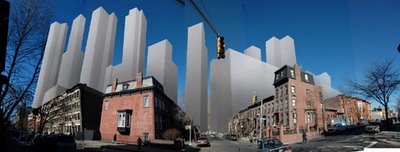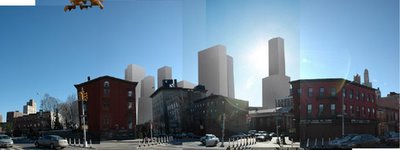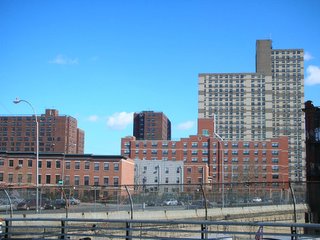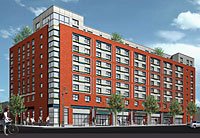 Last month, when I wrote about the very high density of the Atlantic Yards plan, with several of the 16 towers over 400 feet (and one 620 feet), I included Jon Keegan's Google Earth rendering of the proposed building heights in neighborhood context. Now OnNYTurf ("Political and Community Coverage of NYC's 5 Boroughs") has devised a Google map with new portrayals of the footprint. (This is a view from Bergen Street and Carlton Avenue in Prospect Heights.)
Last month, when I wrote about the very high density of the Atlantic Yards plan, with several of the 16 towers over 400 feet (and one 620 feet), I included Jon Keegan's Google Earth rendering of the proposed building heights in neighborhood context. Now OnNYTurf ("Political and Community Coverage of NYC's 5 Boroughs") has devised a Google map with new portrayals of the footprint. (This is a view from Bergen Street and Carlton Avenue in Prospect Heights.)The Gehry plan in the Times
 This example, along with Keegan's, marks an important citizen effort to provide context that the press has so far failed to provide. Remember, we've had the latest set of plans from Frank Gehry since 7/5/05, but the renderings, as published in the New York Times that day, are just a decontextualized splash of skyscrapers.
This example, along with Keegan's, marks an important citizen effort to provide context that the press has so far failed to provide. Remember, we've had the latest set of plans from Frank Gehry since 7/5/05, but the renderings, as published in the New York Times that day, are just a decontextualized splash of skyscrapers. Note that the Brooklyn Papers on 2/18/06 did follow up on Keegan's map and Jonathan Cohn's analysis of the project's scale. Also note criticism of Keegan's post that inclusion of other planned buildings would add some increased scale nearby on Fourth Avenue and in Downtown Brooklyn. (Pictured: the Williamsburg bank tower, and the Bank of New York, both north of Atlantic Avenue near the western border of the Atlantic Yards footprint.)
Note that the Brooklyn Papers on 2/18/06 did follow up on Keegan's map and Jonathan Cohn's analysis of the project's scale. Also note criticism of Keegan's post that inclusion of other planned buildings would add some increased scale nearby on Fourth Avenue and in Downtown Brooklyn. (Pictured: the Williamsburg bank tower, and the Bank of New York, both north of Atlantic Avenue near the western border of the Atlantic Yards footprint.)Density downtown?
Forest City Ratner VP Jim Stuckey, in a panel discussion 11/22/05 for the American Institute of Architects NY Chapter, defended the density: "Many have tried to talk about the scale and the density of this project, the density of this project is really not all that different than what recently went through the public approval process." As I pointed out, Forest City Ratner likes to conflate the Prospect Heights site of the Atlantic Yards footprint with the rezoning in Downtown Brooklyn, but the neighborhoods are not the same.
 As noted by the Pratt Institute Center for Community and Environmental Development in its March 2005 preliminary planning analysis of Atlantic Yards, Slam Dunk or Airball, "When the EIS [Environmental Impact Statement] for the Downtown Brooklyn Plan was completed, it was expected that the new construction for that area would be substantially taller and more modern than what exists. The same is true – and in a substantially greater discontinuity with the majority of surrounding buildings – for the Brooklyn Atlantic Yards area."
As noted by the Pratt Institute Center for Community and Environmental Development in its March 2005 preliminary planning analysis of Atlantic Yards, Slam Dunk or Airball, "When the EIS [Environmental Impact Statement] for the Downtown Brooklyn Plan was completed, it was expected that the new construction for that area would be substantially taller and more modern than what exists. The same is true – and in a substantially greater discontinuity with the majority of surrounding buildings – for the Brooklyn Atlantic Yards area."Stuckey made a reasonable point, that density should be near a transit hub: "In fact, I think that the scale of this project needs to be what it needs to be... The city has an incredible housing shortage, a tremendous housing shortage, by all estimates, 65-70,000 housing units, at all income levels...If you can’t put density in at major mass transportation, where would you put it?"
Density vs. congestion
 But how dense is too dense? There must be a limit. Urbanist Roberta Brandes Gratz, in her book The Living City, writes (p. 25): "Planners, for example, once declared density bad and the thinning out of cities good. Now density is in and thinness out, although a distinction between density and congestion is seldom made. Density comes when many people are in the same place doing things that gain strength from their interaction; congestion results when there are so many of them that interaction becomes difficult, access in and out unpleasant, and frustration high."
But how dense is too dense? There must be a limit. Urbanist Roberta Brandes Gratz, in her book The Living City, writes (p. 25): "Planners, for example, once declared density bad and the thinning out of cities good. Now density is in and thinness out, although a distinction between density and congestion is seldom made. Density comes when many people are in the same place doing things that gain strength from their interaction; congestion results when there are so many of them that interaction becomes difficult, access in and out unpleasant, and frustration high."(This is a view looking south from Fulton and South Oxford Streets in Fort Greene.)
A crazy quilt of density
 Along with the current zoning that has been bypassed--and would dictate much less density--there are some cues for appropriate density for the Atlantic Yards site. Across Atlantic Avenue, for example, the density is a crazy quilt: a 31-story public housing tower, five subsidized co-ops that are 12 to 15 stories, a seven-story building for seniors, and numerous subsidized rowhouses in the Atlantic Commons development. The latter were built in the 1990s; the taller buildings were built in the 1970s. The last building planned for empty land across Atlantic Avenue, to be built by the Fifth Avenue Committee, will be ten stories. The community-developed UNITY plan for the railyards proposed buildings eight to 12 stories. The proposed Extell plan was for buildings four to 28 stories.
Along with the current zoning that has been bypassed--and would dictate much less density--there are some cues for appropriate density for the Atlantic Yards site. Across Atlantic Avenue, for example, the density is a crazy quilt: a 31-story public housing tower, five subsidized co-ops that are 12 to 15 stories, a seven-story building for seniors, and numerous subsidized rowhouses in the Atlantic Commons development. The latter were built in the 1990s; the taller buildings were built in the 1970s. The last building planned for empty land across Atlantic Avenue, to be built by the Fifth Avenue Committee, will be ten stories. The community-developed UNITY plan for the railyards proposed buildings eight to 12 stories. The proposed Extell plan was for buildings four to 28 stories.The density of the Atlantic Yards plan is driven, at least in part, by the developer's need to build enough market-rate housing to ensure desired profits as well as affordable housing to maintain political and community support. Gratz, speaking at a conference Saturday sponsored by the Historic Districts Council, observed. “I’m a little tired of hearing the preservation movement blamed for gentrification. We’ve seen a lot of housing development at suburban density.”
[Addendum: Gratz, in her book Cities Back from the Edge: New Life for Downtown, criticizes the Nehemiah project in East New York for "destroy[ing] the remnants of an authentic urban neighborhood where resources remain to build on... In place of his traditional urban neighborhood, 650 units of only single-family homes with carports were built, a horizontal housing project for homeowners. A low-density suburban housing project on a high-density urban infrastructure, a short walk froim a subway. No traditional neighborhood shopping streets were left within walking distance."]
 Now, she said generally of the city's current predicament, “we are paying a severe price” for having built on vacant land at low density. Does that mean that Atlantic Commons was an inefficient way to provide affordable housing? There are likely much less dense developments in the city [see Nehemiah, above], but her point does resonate. (Note that City Council Member Letitia James, among others, has proposed an expansion of Atlantic Commons on the Atlantic Yards site.) The UNITY plan proposed taller buildings, and the Fifth Avenue Committee's building (right) will be similarly mid-sized. But a decade ago, when Atlantic Commons opened, it "replaced rat-infested lots," as New York Magazine explained. The fact of development apparently trumped any density debate.
Now, she said generally of the city's current predicament, “we are paying a severe price” for having built on vacant land at low density. Does that mean that Atlantic Commons was an inefficient way to provide affordable housing? There are likely much less dense developments in the city [see Nehemiah, above], but her point does resonate. (Note that City Council Member Letitia James, among others, has proposed an expansion of Atlantic Commons on the Atlantic Yards site.) The UNITY plan proposed taller buildings, and the Fifth Avenue Committee's building (right) will be similarly mid-sized. But a decade ago, when Atlantic Commons opened, it "replaced rat-infested lots," as New York Magazine explained. The fact of development apparently trumped any density debate.
Comments
Post a Comment